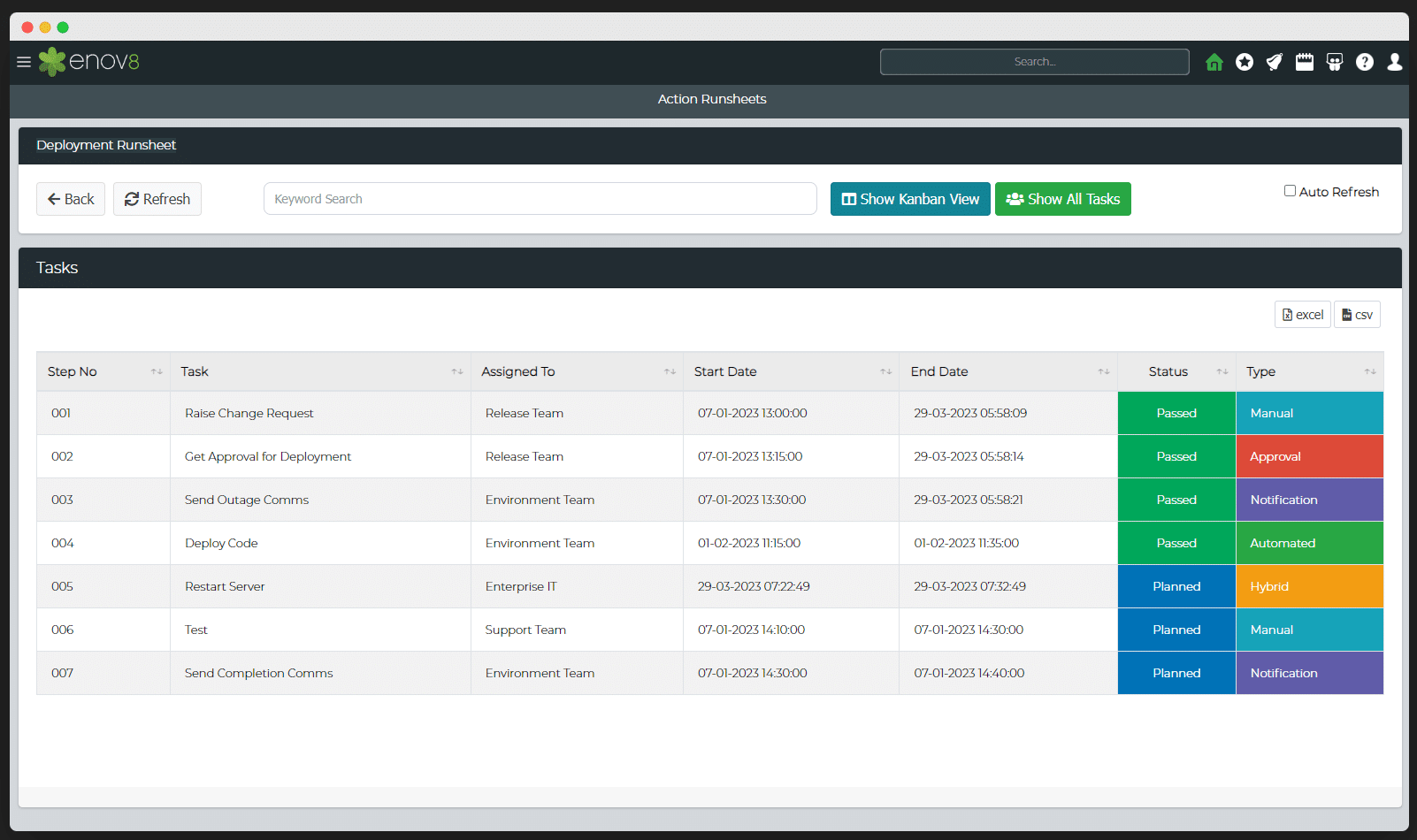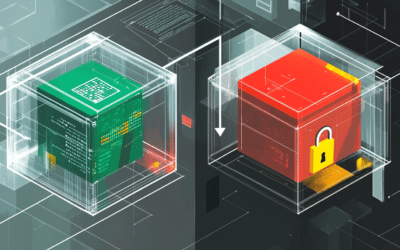
Enov8 – Enhancing IT Resilience
January, 2024
by Jane Temov.
Jane Temov is an IT Environments Evangelist at Enov8, specializing in IT and Test Environment Management, Test Data Management, Data Security, Disaster Recovery, Release Management, Service Resilience, Configuration Management, DevOps, and Infrastructure/Cloud Migration. Jane is passionate about helping organizations optimize their IT environments for maximum efficiency.
In today’s digital era, where business operations heavily rely on digital infrastructure, the concept of IT resilience has taken center stage in organizational strategy. IT resilience refers to an organization’s ability to adapt, recover, and maintain its technology systems in the face of various disruptions, ranging from cyberattacks to natural disasters. The implementation of an IT Resilience Plan is not only critical for ensuring business continuity but also for safeguarding against potential financial and reputational damages.
Innovate with Enov8
A Platform of Insight
Managing your IT & Test Environments, Releases & Data.
Understanding IT Resilience
IT resilience goes beyond traditional disaster recovery approaches. While disaster recovery typically focuses on restoring IT services after an incident, IT resilience encompasses a more comprehensive approach. It not only involves recovering from disruptions but also emphasizes maintaining ongoing operations during such events. This shift signifies a transition from a reactive disaster recovery mindset to a proactive and resilient one.
Components of an IT Resilience Plan
A well-structured IT Resilience Plan comprises several key components:
- Risk Assessment: Identifying potential threats to IT systems and evaluating their impact on business operations.
- Policy Development: Establishing clear guidelines and protocols to manage and mitigate identified risks.
- Technology Solutions: Implementing tools and technologies such as data backups, redundant systems, and failover mechanisms to ensure continuous operations.
- Communication Plan: Outlining how to communicate with stakeholders, including employees, customers, and partners, during and after a disruption.
- Training and Awareness: Ensuring that staff understand their roles in the resilience plan and are trained to respond effectively to incidents.
Data backup and system redundancy play crucial roles in IT Resilience Plans. Data backups safeguard against data loss, while redundancy ensures that alternate systems can seamlessly take over in case of a failure, minimizing downtime.
Developing an IT Resilience Plan
Creating an effective IT Resilience Plan involves several steps:
- Understand Business Needs: Analyze critical business functions and their technology dependencies.
- Conduct a Risk Assessment: Identify potential threats and assess their likelihood and impact.
- Set Recovery Objectives: Define clear Recovery Time Objectives (RTOs) and Recovery Point Objectives (RPOs) for different systems.
- Develop Strategies: Based on the assessment, create strategies to mitigate risks and ensure business continuity, including redundant systems, backup solutions, and other necessary technologies.
- Create a Response Plan: Establish operational procedures (runsheets) for responding to various incidents, outlining roles and responsibilities.
- Plan for Different Scenarios: Consider various disruption scenarios and tailor the response accordingly.
- Consider Compliance and Legal Requirements: Ensure alignment with industry regulations and legal obligations.
Both large and small-scale organizations should tailor their IT Resilience Plans to meet their specific needs, protecting critical business functions under various circumstances.
Challenges in Implementing IT Resilience
Implementing an IT Resilience Plan comes with its share of challenges, including:
- Budget Constraints: Allocating sufficient funds for IT resilience can be a struggle, often due to a lack of understanding of its importance.
- Technology Limitations: Existing IT infrastructure may not support the required level of resilience, necessitating significant upgrades or replacements.
- Staff Training: Ensuring that all staff members are adequately trained and aware of their roles in the resilience plan can be challenging.
- Keeping Pace with Changes: As technology evolves rapidly, keeping the resilience plan updated can be a challenge.
To overcome these challenges, organizations should prioritize IT resilience in their budget planning, invest in scalable and adaptable technologies, provide regular staff training, and establish a process for periodic review and updates of the resilience plan.
How SRE Fits In
Site Reliability Engineering (SRE) plays a crucial role in IT resilience. SRE combines software engineering practices with operational challenges to create highly reliable and scalable software systems. Here’s how SRE contributes to IT resilience:
- Principles of SRE: SRE focuses on automating operational processes, measuring performance, and improving reliability, aligning closely with the goals of an IT Resilience Plan.
- Contribution to Resilience: SRE introduces rigorous engineering practices, including automation, which reduces the risk of human error and improves response times during incidents.
- Automation and Optimization: SRE extensively uses automation to manage system reliability, vital for ensuring uninterrupted service.
- Synergy with IT Resilience Goals: The proactive approach of SRE complements the objectives of IT resilience by anticipating and preventing issues before they impact users.
Integrating SRE principles into an IT Resilience Plan enhances its effectiveness, ensuring that systems can recover from disruptions while maintaining high availability and performance.
Enov8 Environment Management Solution
To support the development and execution of IT Resilience Plans, organizations can leverage solutions like Enov8 Environment Management. Enov8 offers a comprehensive suite of tools and features that enhance the IT resilience planning process:
- System Blueprints: Enov8 provides capabilities to develop detailed system blueprints, helping organizations understand their technology dependencies and critical business functions.
- Standardized Operations: Through Enov8’s runsheets and operational standardization features, organizations can ensure consistent operations even during disruptions.
- Centralized Transformation Planning: Enov8 offers centralized transformation planning capabilities, enabling organizations to manage and execute their IT resilience strategies efficiently.
- Customizable Resilience Dashboards: Enov8’s customizable dashboards provide real-time visibility into the status of resilience measures, helping organizations monitor and manage their IT resilience efforts effectively.
By incorporating Enov8 Environment Management into their IT Resilience Plans, organizations can streamline their resilience strategies, improve visibility, and enhance their overall preparedness to handle IT disruptions.

Emerging Trends and Technologies
The landscape of IT resilience continually evolves with new trends and technologies. Key developments include:
- Cloud Computing: The flexibility and scalability of cloud services make them ideal for building resilient IT systems.
- Artificial Intelligence and Machine Learning: These technologies aid in predictive analytics, helping anticipate and mitigate potential system failures.
- Blockchain: Enhancing security and transparency in data transactions, adding an extra layer of resilience against cyber threats.
- Internet of Things (IoT): While adding complexity, IoT devices offer opportunities for resilience through enhanced monitoring and distributed processing capabilities.
Understanding and integrating these emerging technologies can significantly enhance the robustness and responsiveness of an IT Resilience Plan.
Maintaining and Testing the Plan
For an IT Resilience Plan to be effective, it must be regularly maintained and tested:
- Regular Updates: The plan should be reviewed and updated regularly to reflect changes in technology, business processes, and the external environment.
- Testing Procedures: Regular testing of the plan is essential to ensure it functions as expected during an actual disruption, including backup systems, failover processes, and communication channels.
- Employee Training: Continual training and drills for employees are crucial to ensure they are prepared and understand their roles during an incident.
- Learning from Tests: Analyze test results to identify weaknesses and areas for improvement, and revise the plan accordingly.
Regular maintenance and testing instill confidence among stakeholders that the organization is well-prepared to handle IT disruptions.
Conclusion
In conclusion, an IT Resilience Plan, coupled with solutions like Enov8 Environment Management, is a vital component of any organization’s strategy. It safeguards operations and reputation in today’s digital and interconnected business environment. Understanding the components, addressing challenges, incorporating SRE principles, staying updated with emerging technologies, and regular
Relevant Articles
Enterprise Architecture Tools: 11 to Be Aware Of in 2025
Enterprise architecture (EA) is an essential discipline for organizations aiming to align their IT strategy with business goals. As companies become more complex and technology-driven, having the right set of EA tools is crucial to streamline operations, improve...
What is a Staging Server? An Essential Guide
Release issues happen. Maybe it’s a new regression you didn’t catch in QA. Sometimes it’s a failed deploy. Or, it might even be an unexpected hardware conflict. How do you catch them in advance? One popular strategy is a staging server....
What is Deployment Planning? A Detailed Guide
Deployment planning, sometimes referred to as "implementation planning," is the process of creating a plan for the successful deployment of a new software or system. It involves identifying the resources, tasks, and timeline needed to ensure that the deployment is...
The Definitive Guide to Test Data Generation
Test data generation is a critical part of the software testing lifecycle, ensuring that applications are tested against realistic scenarios before going live. If you’re not testing against production-like data, you’re arguably not truly testing your application. In...
What is a Test Data Manager? A Detailed Introduction
Testing is a critical aspect of software development, and it requires the use of appropriate test data to ensure that the software performs optimally. Test data management (TDM) is the process of creating, storing, and managing test data to ensure its...
How to Manage Test Data in Software Testing
To compete in today's market, software companies need to create programs that are free of bugs and vulnerabilities. In order to accomplish this, they first need to create test data models specifically for staging environments. Test data sets must be compact,...










